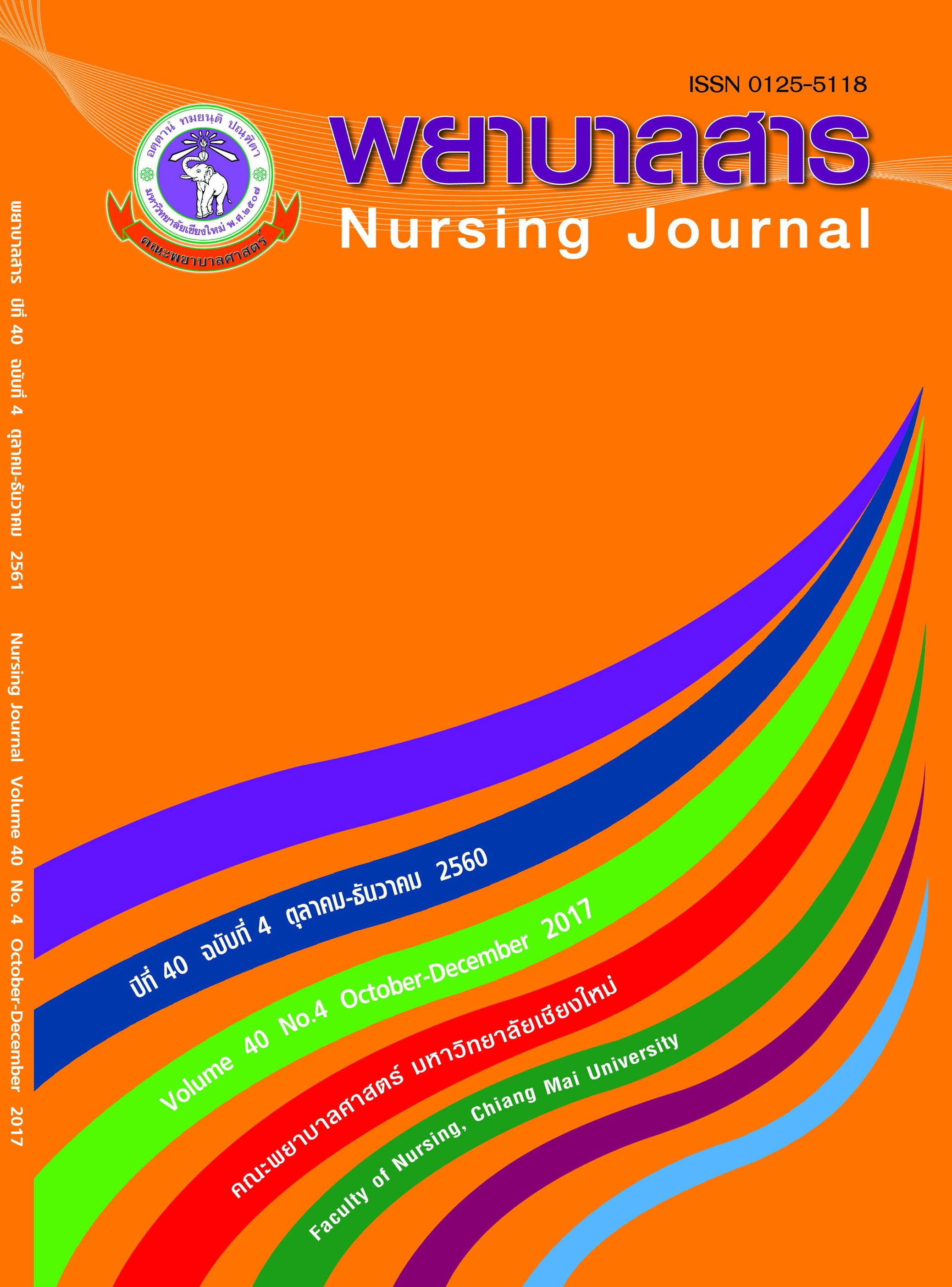Nursing Care for Patients with Targeted Temperature Management Post Cardiac Arrest
Keywords:
Targeted temperature management, Nursing care post cardiac arrestAbstract
Targeted Temperature Management (TTM) is a good outcome treatment for post cardiac arrest patients who have a return of spontaneous circulation (ROSC) with coma. The objective of the treatment is neuro-protection and cardio-protection. The important principle and step of treatment are rapid cooling during induction phase, sustainable targeted temperature during maintenance phase, and slowly increased temperature during rewarming phase. However serious complications may occur every phrase of the treatment. Nurses have a significant role in assessment, monitoring, prevention, and management these complications. Effective care will improve the patients’ survivor with good neurological function. Moreover, patients and families might increase satisfaction with quality of care.
References
arrest. Critical Care Nurse, 27(5), 61-62.
Badjatia, N., Strongilisj, E., Gordon, E., Prescutti, M., Fernandez, L., Fernandez, A., Buitrago, M.,
Schmidt ,J.M, Ostapkovich, N.D, & Mayer, S.A. (2008). Metabolic impact of shivering during therapeutic temperature modulation: The bedside shivering assessment scale. Stroke, 39, 3242-3247.
Beccaria, P.F., Turi, S., Cristofolini, M., Colombo, S., Leggieri, C., Vinciguerra, F., & Zangrillo, A.
(2010). Post cardiac arrest therapeutic hypothermia in adult patients, state of art and practical considerations. HSR Proceeding Intensive Care Cardiovascular Anesthesia, 2(2): 93–103.
Bernard, S. A., Gray, T. W., Buist, M. D., Jones, Bruce M., Silvester, W., Gutteridge, G., & Smith, K.
(2002). "Treatment of Comatose Survivors of Out-of-Hospital Cardiac Arrest with Induced Hypothermia". New England Journal of Medicine. 346(8): 557–563.
Blondin, N.A., & Greer, D.M. (2011). Neurologic prognosis in cardiac arrest patients treated with
therapeutic hypothermia. The Neurologist,17, 241-248.
Callaway, C.W., Donnino, M.W., Fink, E.L., Geocadin, R.G, Golan E., Kern, K.B., Leary, M., Meurer,
W.J., Peberdy, M.A., Thompson, T.M., & Zimmerman, J.L. (2015). Part 8: post–cardiac arrest care: 2015 American Heart Association Guidelines Update for Cardiopulmonary Resuscitation and Emergency Cardiovascular Care. Circulation, 132(suppl 2), S465–S482.
Camp-Rogers, T.R., Sawyer, K.N, McNicol, D.R., & Kurz, M.C. (2013). An observational study of
patient selection criteria for post-cardiac arrest therapeutic hypothermia. Resuscitation, 84:1536-9.
Erb, J.L., Hravnak, M., & Rittenberger, J.C. (2012). Therapeutic hypothermia after cardiac arrest.
American Journal of Nursing, 112(7), 38-44.
Geurts, M., Macleod, M.R., Kollmar, R., Kremer, P.H., & van der Worp, H.B. (2014). Therapeutic
hypothermia and the risk of infection: A systematic review and meta-analysis. Critical Care
Medicine, 42; 231-42.
Keresztes, P., & Brick, K. (2006). Therapeutic hypothermia after cardiac arrest. Dimension in
Critical Care Nursing, 25(2), 71–76.
Kupchik, N.L. (2009). Development and implementation of a therapeutic hypothermia protocol.
Critical Care Medicine, 37(7 Suppl), 279-284.
Nielson, N., Sunde, K., Hovdenes, J., Riker, R.R., Rubertsson, S., Stammet, P., Nilsson, F.,& Friberg,
H., (2011). Adverse events and their relation to mortality in out-of-hospital cardiac
arrest patients treated with therapeutic hypothermia. Critical Care Medicine, 39, 57-64.
Mathiesen, C., McPherson, D., Ordway, C., & Smith, M. (2015). Caring for patients treated with
therapeutic hypothermia. Critical Care Nurse, 35 (5), e1-e12.
McKean, S. (2009). Induced moderate hypothermia after cardiac arrest. AACN Advanced Critical
Care, 20 (4), 343-355.
Peberdy, M.A., Callaway, C.W, Neumar R.W, Geocadin, R.G, Zimmerman, J.L, Donnino, M.,
Gabrielli, A, Silvers, S.M, Zaritsky, A.L, Merchant, R, Vanden, Hoek, T.L, & Kronick, S.L., (2010). American Heart, Association. Part 9: post-cardiac arrest care: American Heart Association Guidelines for Cardiopulmonary Resuscitation and Emergency Cardiovascular Care.". Circulation. 122 (18 Suppl 3): S768–86.
Soleimanpour, H., Rahmani, F., Golzari, S.E.J., & Safari, S. (2014). Main complications of mild
induced hypothermia after cardiac arrest: A review article. Journal Cardiovascular Thoracic Respiratory, 6(1), 1-8.
The Hypothermia after Cardiac Arrest Study Group. (2002). Mild therapeutic hypothermia to
improve the neurologic outcome after cardiac arrest. New England Journal Medicine, 46, 549-556.
Tomte, O., Drægni, T., Mangschau, A., Jacobsen, D., Auestad, B., & Sunde, K. (2011). A
comparison of intravascular and surface cooling techniques in comatose
cardiac arrest survivors. Critical Care Medicine, 39, 443-9.
Downloads
Published
How to Cite
Issue
Section
License
บทความที่ได้รับการตีพิมพ์เป็นลิขสิทธิ์ของวารสารพยาบาลสาร
ข้อความที่ปรากฏในบทความแต่ละเรื่องในวารสารวิชาการเล่มนี้เป็นความคิดเห็นส่วนตัวของผู้เขียนแต่ละท่านไม่เกี่ยวข้องกับมหาวิทยาลัยเชียงใหม่ และคณาจารย์ท่านอื่นๆในมหาวิทยาลัยฯ แต่อย่างใด ความรับผิดชอบองค์ประกอบทั้งหมดของบทความแต่ละเรื่องเป็นของผู้เขียนแต่ละท่าน หากมีความผิดพลาดใด ๆ ผู้เขียนแต่ละท่านจะรับผิดชอบบทความของตนเองแต่ผู้เดียว






